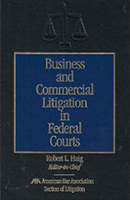 VERDICT: Touchdown!
VERDICT: Touchdown!
Business and Commercial Litigation in Federal Courts (Third Edition)
By Robert L. Haig, editor-in-chief and 251 authors (New York, NY: Thomson Reuters & ABA Litigation Section, 2011 with annual updates). 12 vols., plus CD-ROM. 12,742 pages. $1,392. Order, www.thomsonreuters.com.
Reviewed by Nicholas C. Zales
Business and Commercial Litigation in Federal Courts (Third Edition) sets the standard in treatises on federal court litigation. Written by litigators for litigators, this 12-volume set is an encyclopedia of federal court business litigation from A to Z. First published in 1998 and updated and expanded in 2005, the third edition has 34 new chapters. The treatise comes with an index to all statutes, cases, and regulations cited, and a CD-ROM with many of the forms, checklists, and jury instructions in editable RTF format. It is updated yearly by pocket parts.
Want to review a book?
The following books are available for review. Please request the book and writing guidelines from Wisconsin Lawyer managing editor Karlé Lester, at klester@wisbar.org. Reviewers may keep the book reviewed. Reviews of about 500 words are due within 45 days of receiving the book. Reviews are published, space permitting, in the order received and may be edited for length and clarity.
Who is this book for? Any lawyer or firm that practices in federal court. The amount of procedural and substantive law contained in this set is considerable. It has more than 40,000 citations to the law. In-house counsel will appreciate its clear explanation of a federal lawsuit and suggestions on controlling costs. Written by 251 distinguished federal judges and litigators, the treatise not only sets forth procedural and substantive law in detail but also tells you what you can do with it. The authors offer many valuable strategic tips on how to use federal rules and law. This treatise does not just tell you what the law is. It shows you how to use it.
The first five volumes deal with federal court procedure. The second six volumes cover substantive federal law, including white-collar crimes, securities violations, and pro bono representation.
There are valuable practice checklists at the end of each chapter on every matter from pleadings, motions, and evidence to judgment. The treatise contains an impressive amount of procedural and substantive authority. It contains many references to West’s Key Number Digest, A.L.R., Am. Jur. 2d, C.J.S. and others. If you have just one federal case, you want to have this treatise. It will pay for itself in terms of time, research, and strategy. Even if you only practice state law, you will find a lot of useful information in this treatise, because many state rules and procedures are based on federal law.
Nicholas C. Zales, Marquette 1989, operates Zales Law Office, Milwaukee, focusing on business litigation and appeals. He is a member of the State Bar Communications Committee.
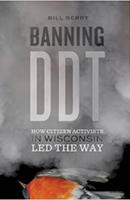 VERDICT: It’s a Keeper
VERDICT: It’s a Keeper
Banning DDT: How Citizen Activists in Wisconsin Led the Way
By Bill Berry (Wisconsin Historical Society Press, 2014). 274 pgs. $18.95. Order, www.wisconsinhistory.org.
Reviewed by Jay Donald Jerde
What does one do when one regularly sees robins twitching and dying on one’s lawn? The people described in Banning DDT decided to act against entrenched scientific expertise and won.
DDT was a wonder chemical. Scientists endorsed it. It seemed the only way to delay the onslaught of Dutch Elm disease, which was destroying a popular type of tree that grew beautifully on city boulevards. But when homeowners found buckets of dead songbirds after spray trucks went by, they began to complain. Local governments disregarded them. The municipalities’ concern was to save the trees. Similarly, the expert opinions of state government agencies and University of Wisconsin academic departments varied. Left with few allies, Wisconsin residents organized. They built a network of activists and scientists.
The subtitle, How Citizen Activists in Wisconsin Led the Way, describes the author’s approach. The book does not go in pure chronological order nor does it provide in-depth coverage of the scientific or administrative law aspects of the successful effort to ban DDT in Wisconsin. It can be difficult to know when we are in the story. Instead, this history presents an impressionistic view. The story moves forward in mini-biographies of ordinary, concerned Wisconsinites who built the groundswell for banning DDT. We meet these people, and they become flesh-and-blood actors who are transformed.
The reader feels like he or she is experiencing current events. Written for a general audience, this book can be read quickly. The author describes how evidence concerning the adverse environmental effects of DDT was gradually built up from various sources. People of diverse conservation interests found common ground. The radical Environmental Defense Fund took the case to administrative hearing before the Department of Natural Resources. Extensive interviews with the participants and use of contemporary newspaper articles bring the issues to life 45 years later.
For the author, this story may be a wistful reminder of when Wisconsin led the nation. Wisconsin was an early battleground in the struggle to ban DDT. The environmental activists who learned through the DDT ban remained active. It’s a generation that is passing away.
Although this book is not a technical treatise, it holds more than entertainment value for attorneys. The movement to ban DDT created a new type of environmental awareness. It set the model for future efforts seeking regulation or limitation of other chemicals or practices. This book is a case study for environmental activism.
Those movements are still out there. By reading the story of a model for successful change, one can appreciate how environmental movements are formed and grow and can succeed. Environmentalists will cheer. Other lawyers may gain insights to defend against such movements.
Jay Donald Jerde, Hamline 2006, is an attorney in Madison with experience in environmental law.
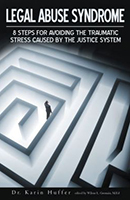 VERDICT: Not for Me, Maybe for You
VERDICT: Not for Me, Maybe for You
Legal Abuse Syndrome: 8 Steps for Avoiding the Traumatic Stress Caused by the Justice System
By Karen Huffer (AuthorHouse, 2013). 218 pgs. $14.66. Order, www.amazon.com.
Reviewed by Sarah Wood
Legal Abuse Syndrome: 8 Steps for Avoiding the Traumatic Stress Caused by the Justice System is largely a “self-help” book written for individuals who have had negative experiences with the justice system and whose mental and physical health may be suffering as a result. The author, Karin Huffer, is a marriage and family therapist in private practice who has worked with many people who have become disillusioned with the legal system and have struggled through the traumatic effects of litigation.
In the introduction, the author writes, “[this is] a book which helps victims overcome the pain caused by their psychological reaction to profound and prolonged injustice.” She takes the reader through eight steps to recovery from what she refers to as “Legal Abuse Syndrome.” This book is filled with techniques that may assist individuals deal with their frustration and seemingly hopeless situations. The steps are interspersed with stories and examples of civil litigants and crime victims who are suffering from the syndrome. Most of the individuals have felt victimized as they struggled through litigation and the justice system in general, and the author presents their point of view in a nonjudgmental way.
It is worth mentioning that notably absent from this book are stories of “non-innocent” individuals. Stories of criminal defendants are not discussed, which seemed to me to be a disservice as there are likely many criminal defendants, wrongly accused or not, who have been treated unfairly by the justice system, just like the other individuals mentioned in the book.
That aside, this book may prove to be a good resource for individuals who feel they have been traumatized, alienated, or otherwise victimized by the justice system. But the book’s target audience is not lawyers (the individuals discussed were often dissatisfied or frustrated with their attorneys), and it is unlikely that the majority of this book would be useful in one’s daily practice.
There are a few exceptions, of course; for example, attorneys may find the discussion of listening techniques helpful, in the event that one’s client appears to be struggling with the syndrome. Additionally, attorneys may consider recommending this book to clients. Overall, this book will be a good resource for individuals suffering from traumatic stress as a result of litigation and other encounters with the justice system, and attorneys might want to recommend it to clients possibly struggling with the issues covered in this book.
Sarah E. Wood, U.W. 2013, is an estate planning and probate attorney at Gustafson Gervasi Law Office LLC, Madison.
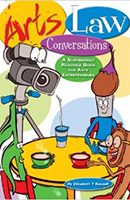 VERDICT: Touchdown!
VERDICT: Touchdown!
Arts Law Conversations: A Surprisingly Readable Guide for Arts Entrepreneurs
By Elizabeth T. Russell (Madison, WI: Ruly Press, 2014). 320 pgs. $21.95. Order, www.rulypress.com.
Reviewed by Kathy Kjorlie
Do not let the whimsical characters on the front cover fool you. Elizabeth T. Russell’s new book, Arts Law Conversations: A Surprisingly Readable Guide for Arts Entrepreneurs, provides a comprehensive overview of arts-related intellectual property law. While technically geared toward artists and professionals who work with them, this practical reference also has broad appeal for any layperson or attorney. The author explains many issues that might await the creative artist, whether amateur or professional, and every attorney will be better equipped to serve clients with this information.
Knowing the author both personally and professionally, I found her writing style to be similar to how she speaks: clearly, to the point, and with a bit of humor to keep you engaged and entertained. The book is organized into four sets of “conversations,” 52 in all. Whether several characters are speaking in Q&A fashion or the topic is presented as a story or mini-lecture, this format provides a fun and enjoyable learning experience.
After some basic information about the legal system, the vast majority of material is in the intellectual property section. Within that, copyright issues predominate, starting with a concise explanation of the bundle of rights before delving into each one. Trademarks are second in terms of exposure, and patents and trade secrets are also touched on. Concepts such as fixation, original expression, derivative works, licensing, registration, publication, duration, fair use, infringement, termination, and many more are covered extensively and in detail. The book wraps up with contracts and business issues.
Throughout the text, complex concepts are broken down into digestible pieces. While it is satisfying to step through the logically organized progression, one need not read this book straight through. Each conversation is distinct and separate, with varying levels of complexity, and topics are easily found in the table of contents. Helpful charts and diagrams are used sparingly yet powerfully, and the glossary and index are extensive. Most conversations end with short exercises, which may be thoughts to ponder or additional material to look up. The reader will quickly learn to keep the Internet handy, as these teasers are intriguing. Court cases cited and discussed throughout the book are thoughtfully chosen for both educational and entertainment value.
In addition to conveying a vast amount of information, the author keeps everything lively with her direct style and witty humor. Many practical things can be learned from this book, not the least of which is how to recognize “plop art” when you see it. After you read and enjoy this text, it will serve as a handy reference on any shelf.
Kathy Kjorlie, U.W. 2009, is principal of Kjorlie Law LLC, Madison. She practices primarily in estate planning, probate, and real estate.
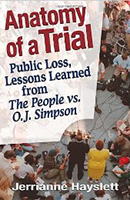 VERDICT: Not for Me, Maybe for You
VERDICT: Not for Me, Maybe for You
Anatomy of a Trial: Public Loss, Lessons Learned from The People vs. O.J. Simpson
By Jerrianne Hayslett (Columbia, MO: Univ. of Missouri Press, 2013). 272 pgs. $27.49. Order, www.amazon.com.
Reviewed by Neal S. Krokosky
Anatomy of a Trial is a behind-the-scenes narrative of the O.J. Simpson criminal trial resulting from the deaths of Nicole Brown Simpson and Ronald Goldman. Or, as the author correctly summarized: “Anatomy of a Trial tracks how [Judge Lance A.] Ito went from judicial paragon to a caricature of an inept black-robed celebrity wannabe and examines not only the media’s crucial role, but also Ito’s and my own unwilling culpability ….”
Jerrianne Hayslett was the Los Angeles court’s information officer and media liaison, a daily presence in the courtroom and in the chambers of Judge Ito. Accordingly, the book provides a unique, insider’s perspective into the events related to “the trial of the century.” It also serves as a partial biography of Judge Ito, including how the trial affected his personal and professional life.
The author attempts to use anecdotal, primarily subjective, evidence to answer the question she sets forth in the introduction: “The manifestations of the Simpson fallout are clear, but why did the trial have such an [sic] far-reaching and lasting impact?”
Hayslett provides many examples, buttressed with insight from notable players, to support her answer: “the character and approach of the trial judge, Lance A. Ito; what was happening off camera; the synergistic effect that the behind-the-scenes activities, the trial participants, the media, a number of peripheral characters, and, most significantly, the judge had on one another; and other judges’ perceptions of and reactions to the trial and Ito.”
The primary audience for this book is individuals interested specifically in this trial, because the book is a bit light on the “lessons learned” referenced in the title. While one could, based on observations scattered throughout the book, create a list of takeaways, they were not succinctly stated along the way. And, for readers primarily interested in how to avoid or remedy problems that arise between the courts and the media, there is little reason to read more than the last chapter, appropriately titled: “A Blueprint.”
Overall, the book was worth the read. However, it contains relatively few everyday lessons for practicing attorneys and even fewer for those who are not involved in high-profile-trial practice.
Neal S. Krokosky, U.W. 2009, practices with Weiss, Berzowski & Brady LLP, Milwaukee.
 VERDICT: It’s a Keeper
VERDICT: It’s a Keeper
Sweatshops in Paradise: A True Story of Slavery in Modern America
By Virginia L. Sudbury (Bloomington, IN: iUniverse, 2013). 163 pgs. $16.95. Order, www.amazon.com.
Reviewed by Jeffrey P. Kippa
This book’s subtitle, “A True Story of Slavery in Modern America,” conveys the sad and appalling story inside. It harkens back to early John Grisham books in which the underpowered little law firm is suddenly rocked with a David and Goliath battle against big bad corporate powers. Only, this one is true. The author does an amazing job of painting the feel of island life while telling the compelling story of her legal battle. Her ability to keep things light between courtroom battles helps to make this an easy read.
In a time when we are all inundated with 24/7 news, it is surprising that the facts of this book have gone relatively unreported. Perhaps this is a result of the media already being saturated with tragic news clippings on a daily basis or perhaps it is a grand conspiracy of global corporations to keep us shielded from these tragedies.
A Korean-owned corporation that employs Vietnamese women set up shop in the U.S. territory of American Samoa but seems little swayed by any employment laws. Not only do these women work in poor conditions but also they are often not paid their paltry wage and threatened with deportation if they try to speak out. The narratives of the book are interwoven with newspaper clippings pertaining to the unfolding court battle and thus it gives insight to perspectives other than the author’s.
While the definition of an “unincorporated territory” remains a bit of a mystery, the fact that the United States is at all affiliated with a place that allows ill treatment of workers legally within its borders is truly disheartening. Ultimately, the reader is left feeling better for the workers in this book, but also is left wondering whether anything will change in the long run. It is clear that without the assistance of strong advocates such as the author, little will change for subsequent waves of workers.
Jeffrey P. Kippa, Marquette 2001, practices criminal defense at J. Kippa Law LLC, Appleton.
 VERDICT: It’s a Keeper
VERDICT: It’s a Keeper
How Blue Are the Ridges
By Ken Ollis (Bloomington, IN: iUniverse LLC, 2013). Novel. 591 pgs. $29.78. Order, www.amazon.com.
Reviewed by Brandon E. Bowlin
In his novel, How Blue Are the Ridges, Ken Ollis paints a picture of the Great Depression in the Blue Ridge Mountains of North Carolina. Using the colors of faith, hope, and love, the reader obtains an intimate knowledge of what the people had to go through to survive. The author taps into the depths of human emotion that help to place the reader in the shoes of the main characters. The characters have dreams of overcoming poverty and seem to stop at no cost to accomplish their goals and fulfill their dreams. This includes becoming involved in the sale of illegal moonshine. The characters find out quickly that the pursuit of their dreams will be dangerous when they cross over into the world of organized crime.
At times, the reader becomes lost in the immense amount of detail that the author provides. It detracts from the story line and slows the pace of reading. The book can be divided into two parts. The first half of the book moves at a slow pace as the scene of the Great Depression is set. This is where most of the intrinsic details are found. The pace picks up in the second half, and you find yourself on the edge of your seat for the remainder of the story.
The book’s strength is that the author makes it easy for readers to think about what they would do in a similar situation. The author does an excellent job of making the characters real and relatable. The author had a few purposes or points he wanted to highlight, all of which he accomplished. First, he gave a real portrayal of the Great Depression. Second, he emphasized the importance of being blessed with the gifts of faith, hope, and love. At various points throughout the book, he makes it clear that the most important day of the week is Sunday. Finally, he provides a cautionary tale of success and how it changes who a person is, no matter how good the person’s heart and soul.
Brandon E. Bowlin, Dayton 2004, practices in creditor’s rights in Milwaukee.
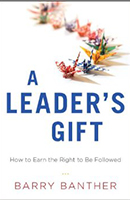 VERDICT: Touchdown!
VERDICT: Touchdown!
A Leader’s Gift: How to Earn the Right to Be Followed
By Barry Banther (Austin, TX: Greenleaf Book Group Press, 2014). 172 pgs. $15.66. Order, www.amazon.com.
Reviewed by Aaron P. Frederickson
Walk through any bookstore and you will find countless books on leadership and building a winning team. Most of these self-help books for the rising professional and entrepreneur are filled with tall tales of why the author succeeded and you fail.
In A Leader’s Gift: How to Earn the Right to Be Followed, Barry Banther takes the uncommon approach to leadership, or what he calls, “the right to be followed.” In this page-turner on professional development and leadership, the author takes us beyond the open-door policy most corporate professionals claim to possess in the office place. Unlike most critically acclaimed anecdotes on this topic, readers will find that true leadership goes beyond this mythical policy and requires supervisors and managers to learn proactively what makes their employees tick and feel a part of a team. According to Banther, these are really “gifts” leaders give to the people they manage: the gift of being open to others; the gift of investing time in others; the gift of listening to others; the gift of offering encouragement to others; and the gift of expressing appreciation for others’ abilities.
In highlighting these gifts, Banther takes the approach that “leadership isn’t just something you do, it is someone you become.” He provides excellent illustrations of this premise from his personal experiences and how at some points in his drive to be a leader, he was, in fact, a hypocrite. Part of his approach also extends to building lasting relationships with not only the people he is charged with supervising but also vendors and clients. In order to do so, he takes the position that the needs of others must come first.
While this book has a tendency to touch on one’s emotions, it is clearly different from other books in the same genre. It is clearly a necessary read for anyone in the legal profession seeking to guide a law firm to success. Given the current surplus of attorneys and competitive billing rates, it is easy to focus on the bottom line and ignore the human capital any firm should be investing in on a daily basis. This is also true as firms seek to improve profit margins, while at the same time maintain a high level of morale with support staff and associate attorneys.
Overall, I give this book a high mark. Banther offers a unique perspective from the business side of things and provides the reader with real-life experiences on how he has not only succeeded but also failed to be a leader. He also points out that true internal efficiencies can be realized when leaders within an organization are proactive in their management of personnel and understand their interests.
Aaron P. Frederickson, William Mitchell 2002, operates MSP Compliance Solutions LLC, Circle Pines, Minn.
